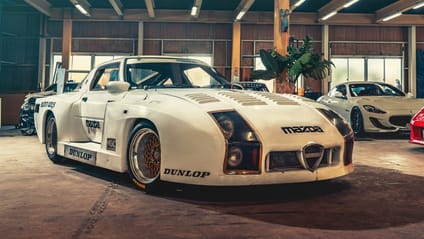
Someone has found Mazda's long-lost Le Mans car
Call off the search party: after 37 years in hiding this unique RX-7 is being restored


Given we’re living in an age of being permanently tethered to our phones, and considering there are only a finite number of barns in the world, you’d think the days of ‘barn finds’ would be numbered. Not in Japan.
The idea of oversharing information on the internet hasn’t ruptured the East like it has the West, so there are still unknown gems to be found. And not in barns, but seeming car-y catacombs of awesome. See, the barn finds over in Nihon aren’t some Mercedes 300SL that’s been tucked away as an appreciating heirloom. Rather, they’re simply vehicles vanquished from the annals of time because people forgot that they own them.
Take this Mazda RX-7, for example. As you can see, it’s no ordinary RX-7. Rather, a Le Mans-ified Mazda 254i that competed in the most famous endurance race on Planet Earth in 1982. The 254i is a significant car too, being the first Mazda to finish the tortuous 24-hour race. That year, Mazda entered a few cars, a No. 82 car (driven by Yojiro Terada, Allan Mofatt, and Takashi Yorino) that placed 14th overall and sixth in category, and a second car – No. 83 (driven by Tom Walkinshaw, Chuck Nicholson, and Peter Lovett). That got up to 8th place before retiring after 180 laps. But considering this was the first time any Mazda had seen the chequered flag, it was as good as a win for the bosses back in Hiroshima.
Photography: Mark Riccioni
Advertisement - Page continues below
But with the FIA introducing the now iconic Group C class for prototypes that same year, teams quickly switched over to the new regs and madder cars. Mazda followed suit, introducing the 717C in 1983. With its enclosed wheel spats, cutesy face and a superior racing championship to compete in, it instantly jumped to the front of everyone’s brain and became the memorable Mazda from Le Mans. Well, until the Le Mans-winning 787B of 1991 rocked up with its ballistic quad-rotor engine and wiped everyone's memory of both the 254i and 717C. Seemingly, even Mazda’s.

After Le Mans, the pair of 254is that competed in 1982 flew back to Japan and competed in various races on the JPSC calendar along with other privateer cars. One was painted pink and one was painted yellow, but the line of which became which was a bit hazy. What we do know is that the No. 83 car finished the Fuji 1000km in 1984, retired after a race at Tsukuba then… well, it just vanished off the face of the planet.
Literally no one knew what happened to it. Not even Mazda. So when one was found in Okayama by rotary royalty Isami Amemiya – owner of legendary tuning house RE Amemiya – he rushed there as quickly as he could. But there wasn’t just one car, but two. Joining one of the Le Mans cars was an IMSA spec car. Amemiya-san got his wallet out and snapped that up, then offered the Le Mans car to his mate, Masachito Ito, owner of specialist carbon composite and exhaust firm, PowerCraft.
Advertisement - Page continues below
“I had no idea what it was,” Ito-san (a man with the fastest hair in the world) told us. “But I thought it was cool and wanted to daily driver it – so I bought it”.
As you can imagine, Ito-san is a bit of a dude. But it was only when he got back to his workshop in Gotemba that he realised what he’d bought. Well, he didn’t – but the internet did. As soon as the car surfaced its history started to reveal itself thanks to the otaku (car geeks if you don’t speak Japanese). A community on Twitter helped piece together the car’s past in detail, then Tachimoto-san, the chief mechanic at Mazdaspeed at the time the 254i competed, confirmed the car in question to be the No. 83.

The brake system and rear suspension were a big giveaway. As was the fact it recycled its predecessor’s (the 253i) chassis, just with new flared bodywork and Eighties-tastic aero plonked on top of the standard body. As the internet army had deep-dived on the No.83 car, they realised that the Le Mans finishing No. 82 car was destroyed in a crash at Fuji Speedway’s 100R, making the importance of this car resonate further.

The plan is to restore it back to its former glory – as in a full-on barebones build-up to be in the exact spec that it raced at Le Mans in 1982. As this is Japan, you can bet your bottom dollar it will happen and will be 100 per cent authentic. Being a bodywork specialist, Ito-san will do all the aesthetics while RE Amemiya will then do the engine.

If there’s one company you want to build a rotary engine for you, it’s RE. In period, the 254i ran a dual-rotor 13B Wankel. These esoteric engines are always Mazda’s defining hardware; offering compact, lightweight propulsion with fewer moving parts than a traditional piston engine. If you’re not familiar with rotaries, imagine a triangle spinning inside an oval housing like a rotisserie Dorito. This whizzes around creating chambers that expand and shrink, so when you pop the fuel and spark in at the perfect time you have a three-phase version of suck, squeeze, bang, blow – just every spin is a power stroke. They also make a fantastic noise.
Advertisement - Page continues below
All going well, the car should be in shape in the next two years. Every teeny, weeny detail will be accounted for and as the Le Mans car pumped out around 296 horsepower back in the day (rookie numbers for RE who can push its rotaries to the stratosphere) it will be the same. Personally, we can’t wait to see how it ends up as oddities like this deserve a second life.
So consider this is a public service announcement to everyone in Japan: please go and look what’s in your shed, because you never know, you may have gold like this.
Trending this week
- Car Review
Hyundai Kona
- Long Term Review
Time's up with the Mini Countryman: here's the six-month verdict







